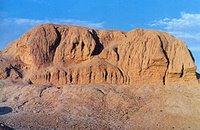Chess was Invented by Persians!

The origins of chess are obscure, and it is not until the 7th century that there is a reference to the game in literature. The first mention of chess is found in a Persian poem according to which the advent of the game took place in India. Chess migrated to Persia (Iran) during the reigns of King Chosroe-I Annshiravan (531-579) as described in a Persian book of this period. This book described chess terminology and the names and function of the major pieces/minor pieces in some detail. Chess is also mentioned in the poems of Firdousi, a Persian poet of the 10th century in which he describes gifts being introduced by a convoy from the Rajah of India at the court of the Persian King Chosroe-I. Amongst the gifts was a game which depicted the battle of two armies.
Records show that there were originally four types of pieces used in chess. Shatrang (Indian Sanskrit) means ‘four’ and anga means ‘detachment’. In the Sassanid dynasty (242-651 AD) a book was written in the Middle Persian Pahlavi language called ‘Chatrang namakwor’ (A Manual of Chess). Shatrang (chess) represents the universe, according to ancient Indian mysticism. The four sides being the four elements (fire, air, earth and water), and the four ‘humors’ of man. Although the names of the MPs/mps are different in various countries today, their movements are strikingly similar. In Persia the word ‘Shatranj’ was used for the name of chess itself. The Persians took up Indian chess with enthusiasm. The caliphs, rulers of the Moslem world, kept chess professionals at court through the 9th and 10th centuries. Chess was used by Persiansas a way to define war strategies within the Persian army. On the chessboard, the black and white squares simplify both the battlefield and the circumstances to improve comprehension, the pieces strictly reflect the fabric within the imperial Persian governments. The vocabulary and the rules of the game which are distinctly Persian, has therefore made the game a household hobby with a natural presence among Iranians.
Chess was brought to Europe by the Moors in Spain before AD 1,000.
Records show that there were originally four types of pieces used in chess. Shatrang (Indian Sanskrit) means ‘four’ and anga means ‘detachment’. In the Sassanid dynasty (242-651 AD) a book was written in the Middle Persian Pahlavi language called ‘Chatrang namakwor’ (A Manual of Chess). Shatrang (chess) represents the universe, according to ancient Indian mysticism. The four sides being the four elements (fire, air, earth and water), and the four ‘humors’ of man. Although the names of the MPs/mps are different in various countries today, their movements are strikingly similar. In Persia the word ‘Shatranj’ was used for the name of chess itself. The Persians took up Indian chess with enthusiasm. The caliphs, rulers of the Moslem world, kept chess professionals at court through the 9th and 10th centuries. Chess was used by Persiansas a way to define war strategies within the Persian army. On the chessboard, the black and white squares simplify both the battlefield and the circumstances to improve comprehension, the pieces strictly reflect the fabric within the imperial Persian governments. The vocabulary and the rules of the game which are distinctly Persian, has therefore made the game a household hobby with a natural presence among Iranians.
Chess was brought to Europe by the Moors in Spain before AD 1,000.


